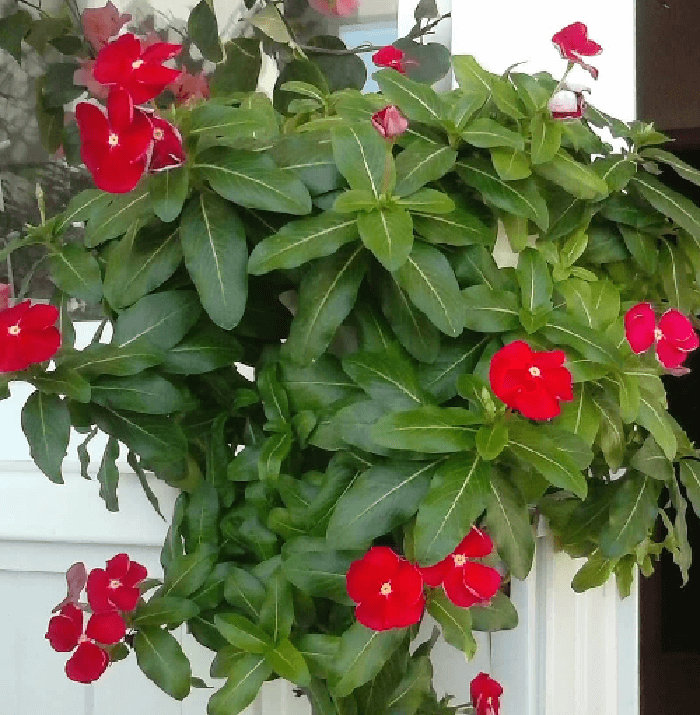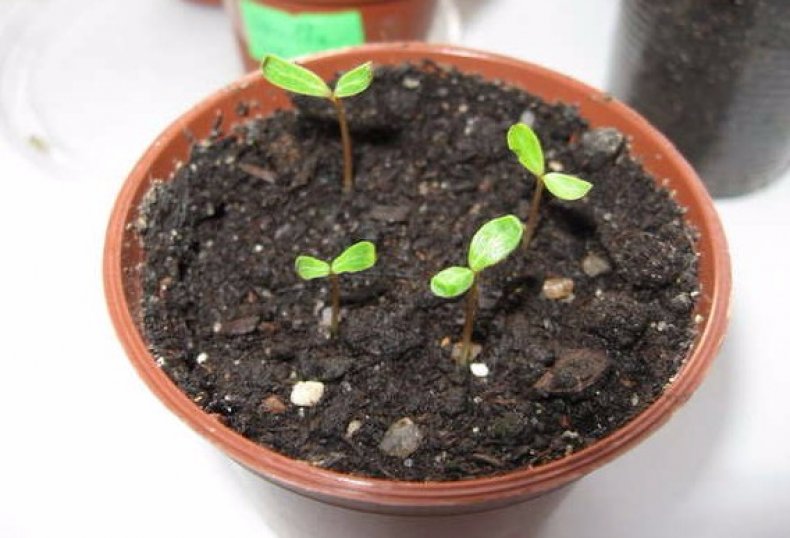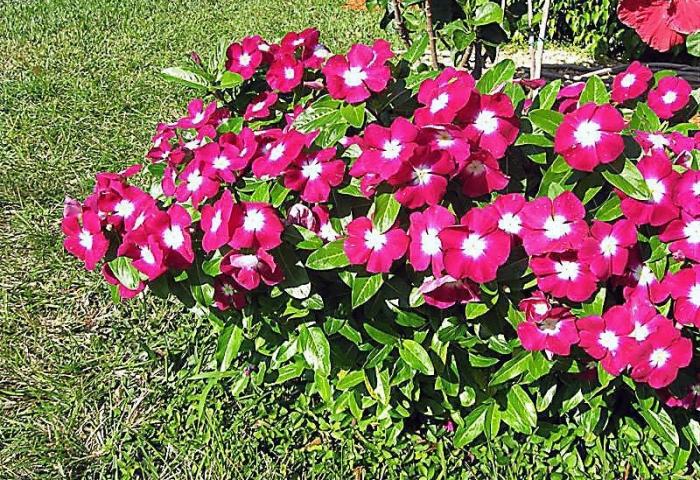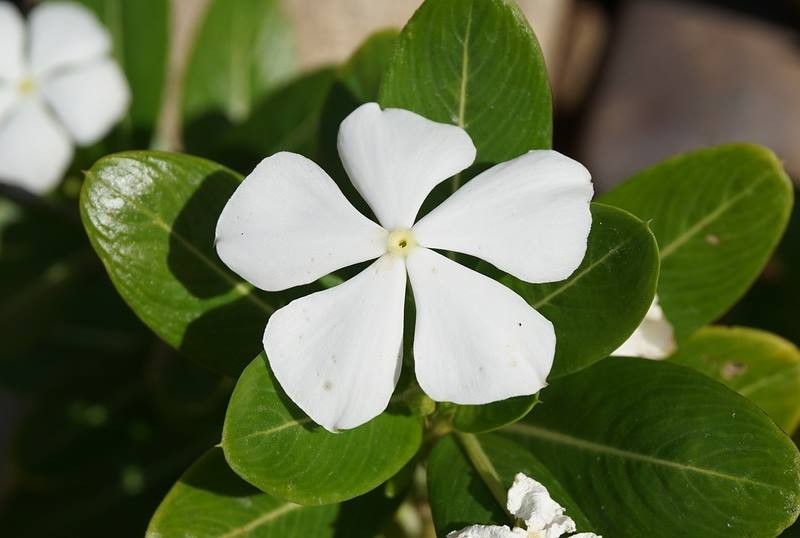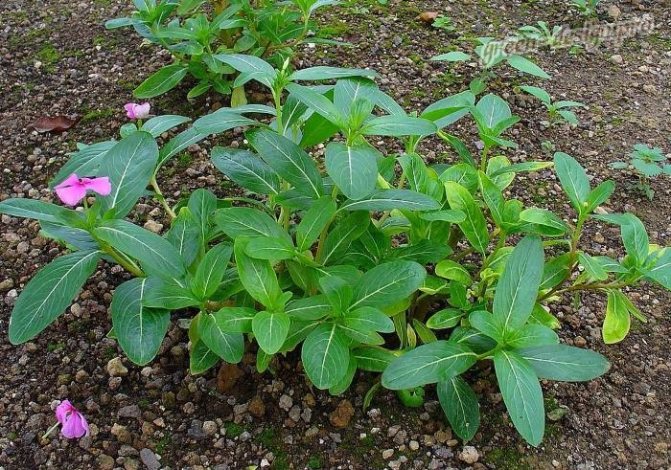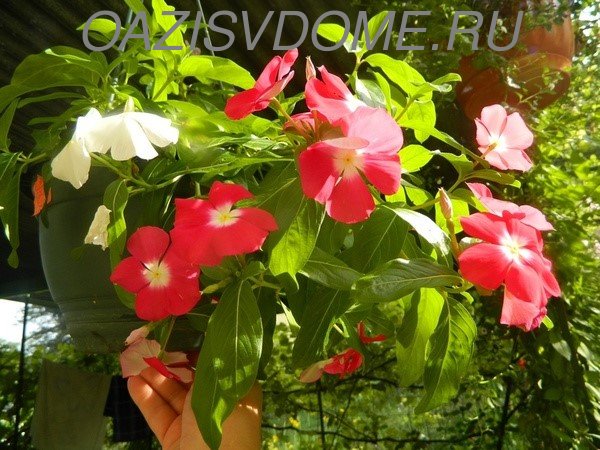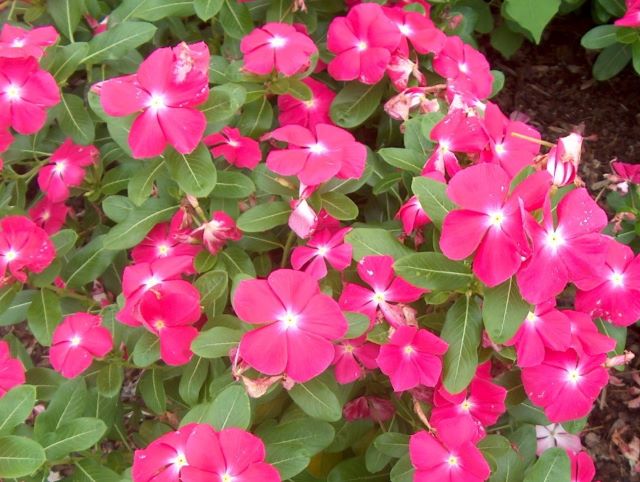General information
Katarantus is a representative of the Kutrov family. It is a shrub. There are both perennial and annual varieties.
The name is translated from Greek as a pure flower. It was given for bright flowers, painted in pure colors.
The plant has a large number of aliases. Some of them are: periwinkle, cayenne jasmine, pink periwinkle, lochner, "old maid". This confusion occurred because scientists attributed it to the genus periwinkle.

Katarantus
This was due to the similarity of plants, but a detailed study revealed differences. Then the catharanthus was attributed to the genus Lochner, then migrated to the genus Ammocallis. Finally, in 1837, botanists described a new variety and named it Catharanthus.
While scientists were determining the belonging of a flower to a particular genus, people got used to its names. As a result, confusion continues to this day.

The flower is called differently: pink periwinkle or rose wine.
With his homeland, too, everything is confusing. In nature, it grows in Madagascar, the Philippines, Indonesia, Africa, the Indochina Peninsula.
Features of the appearance of the catharanthus:
- Strong trunk with many branches. The color of the shoots is green, maybe with a pink tint.
- Green leaves have a beige vein and shine. They sit on short petioles.
- The height reaches 60 cm.
- The flower consists of 5 petals. Their color is from white to burgundy.
Views

Types and varieties of catharanthus
Katarantus is divided into 8 species, which contain several varieties. Most of them grow in Madagascar, so this island is considered their homeland.
Views:
- Catharanthus pusillus
- Catharanthus coriaceus
- Catharanthus lanceus
- Catharanthus longifolius
- Catharanthus ovalis
- Catharanthus roseus
- Catharanthus scitulus
- Catharanthus trichophyllus
At home, only pink catharanthus is grown. It is an evergreen bushy plant. At home, it grows up to one and a half meters, in our latitudes the height reaches no more than 60 cm.

Catharanthus lanceus
It has lanceolate leaves, with a characteristic beige vein in the middle. They are 7 cm long. They have a smooth edge and a glossy surface.
The shades of flowers depend on the variety. The flowering period is long, depending on weather and climatic conditions. In cold regions, it blooms from early spring to late summer. The warm climate encourages the catharanthus to bloom all year round.
This series is presented in several varieties:
Ampelny, cascade, mediterranean

Ampelny, cascade, mediterranean
Ampelny, cascade, mediterranean
- These are low varieties. The height of the bush is no more than 15 cm.
- Their difference is in long hanging shoots, which can reach 150 cm.
- All three varieties have large flowers, in which the color smoothly passes from a light shade from the edge of the petal to a dark one in the middle.
Aristocrat

Aristocrat
Aristocrat
- This variety grows up to 50 cm.
- Suitable for growing both in the garden and indoors.
- Flowers can be from white to deep red.
- They definitely have a contrasting eyelet.
- They are large in size, their diameter is 5 cm.
Pacific

Pacific
Pacific
- This is a miniature plant, its height reaches no more than 30 cm, and the cap has a diameter of 20 cm.
- The difference in the variety is in the bright middle of the flower, in a contrasting color.

Pacific burgundy
Pacific burgundy

Pacific epricot
Pacific epricot
Pacific white

Pacific white
Pacific white
- Differs in monochromatic snow-white flowers.
- Sometimes the central part can be colored red.
First kiss

First kiss
First kiss
- Differs in large flowers of saturated shades.
- There are 13 of them in this variety.
- The most unusual one is violet-blue.
- Bushes are low, their maximum height is 40 cm.
Quince: rules for planting in open ground, caring for a fruit tree with fragrant fruits from the Moscow region to Siberia. Reproduction methods (35 Photos & Videos) + Reviews
1 Landing
Experts do not advise to immediately sow catharanthus seeds in open ground. It is best to use the seedling method.In this case, the algorithm of actions will be as follows:
- 1. Prepare the soil. Mix equal volumes of peat, humus, turf and leafy soil. It is imperative to sterilize the resulting substrate. To do this, it is supposed to be treated with a solution of potassium permanganate. It should be light pink.
- 2. Choose wide seedling containers. There should be holes at the bottom to drain the water.
- 3. Pour a layer of drainage into the pot. For example, you can use expanded clay, pebbles, gravel, stones, broken brick, etc.
- 4. Fill in the substrate.
- 5. Make 1.5 cm deep furrows in the ground.
- 6. Sow store-bought seeds in the furrows and cover with soil.
- 7. Spray the substrate with water.
- 8. Cover the container with plastic wrap and place in a warm place. The temperature should be 23-25 C.
Catharanthus usually germinates from seeds within a week. As soon as the first shoots appear, the film must be removed. The container with seedlings should be placed in a well-lit place. The temperature should be 18-21 C. Periodically, the soil must be moistened
In addition, you should gently loosen it around the sprouts.
After 2 weeks after the first shoots appear, it is necessary to feed. Nitrogen must be present in the fertilizer in a nitrate form. You will need products containing phosphorus.
When the sprouts reach a height of 7-8 cm, and they have 4 real leaves each, it is necessary to make a pick, that is, to plant them in separate small pots. This option is suitable for those cases when there are plans to further move the flower to the garden. But if the catharanthus remains a home (indoor) plant, then the seedlings should be placed in pots or large pots. One container can hold 3 flowers.

Planting in open ground should be carried out in late spring or early summer, so that the weather is already warm and sunny, and frosts do not return at night. But before transplanting seedlings into open ground, it is supposed to be hardened. To do this, every day you need to take out the pots of plants to the open air. Each time, the duration of the session must be increased. Planting into the garden can be carried out when the plants will be outside the whole day.
Before planting the catharanthus in the garden, you must choose an open place, but protected from drafts and strong winds. The soil on the site should be fertile and loose. The acceptable acidity level is 5.6-5.8. Before planting, the soil is supposed to be dug up, adding peat, turf and leafy soil. Seedlings do not need to be placed too close to each other. The distance between them should be 30-70 cm - it depends on the variety. To get more compact bushes, experts advise pinching 1-2 branches.
Catharanthus reproduces not only by seeds. You can use the method of cuttings or dividing the shrub. In the latter case, it is necessary to use particles. They are formed when the central part of the rhizome dies off and the stem becomes tree-like. As a result, the catharanthus splits into separate parts. They are capable of a normal independent life. It is better to divide the bush in the middle of spring. With this method of propagation, the flower quickly takes root and grows rapidly.

Cutting is a method in which propagation is carried out using branches that gradually take root. It is necessary to cut off the upper parts of the shoots of the mother shrub in the spring. The angle on the cut should be 45. The branches are supposed to be placed in previously prepared containers with a substrate and periodically moistened. The root system with this method of reproduction is formed quickly enough.
3.Katarantus - home care
3.1. Reproduction, growing from seeds
Katarantus, unfortunately, is a short-lived plant and is often simply thrown away after flowering or in spring, having taken care of the cuttings in advance.
- Vegetative propagation is carried out using stem cuttings 8-10 cm long, taken in the spring.
- Remove the leaves from the lower ends of the stems and immerse the cuttings in rooting powder and then in a wet mixture of peat and sand.
- Cover the seedling pots with a clear plastic wrap or glass to maintain moisture.
- Place the plants in a warm place with a temperature of about 22 ° C, protected from direct sunlight.
- The successful completion of the rooting process will be indicated by the appearance of new growth - young twigs and leaves, at which time the shelter can already be completely removed.

Rooting is successful even in a simple glass of water, however, after planting in the ground, such plants slow down slightly in growth - thus their root system adapts to new conditions of existence.
It does not make sense to use adult stems for vegetative propagation - they can stand in water for a long time without visible signs of the appearance of roots, therefore, the catharanthus is propagated by young apical cuttings.

When grown indoors, you can harvest your own seeds.
To obtain seeds, the plant is kept all year round at normal room temperature with good lighting in the autumn and winter months.
The flowering of the catharanthus ends in mid-spring and the seeds ripen for about another six months.
Unfortunately, seed-derived bushes may not inherit all the attractive qualities of their parent plants.
Fresh seeds have the highest germination capacity.

- Before sowing, the seeds are pre-soaked in warm water with the addition of a small amount of potassium permanganate and growth hormones.
- Sowing is carried out in a well-moistened, nutritious substrate, covering with a layer of earth about 1 cm thick.
- The seedlings are placed in a warm place, shaded from direct sunlight and covered with a transparent plastic cap, glass or a simple plastic bag to maintain uniform moisture.
- Periodically, instead of watering, the soil is moistened or sprayed with a fine spray.
- The first shoots can be seen within 7 to 14 days. At this time, containers with crops are placed in a brightly lit place without direct sun with a temperature of about 23 - 25 ° C.
- The shelter is removed daily, gradually increasing the airing time and removing condensate from it.
Young plants develop slowly and often seem to just stand still.

The first feeding is carried out with a weak solution of flower fertilizer when the seedlings are about 2 weeks old.
The first dive is carried out with the appearance of 4 real leaves - the flowers are planted in separate cups. The procedure is carried out very carefully, since it is very easy to damage the delicate and young root system and it already lies deep enough.
Since growth accelerates over time, several picks may be required as the size of the pots increases.
In plants obtained from seeds, the first buds appear 60 - 70 days after germination.

Adult catharanthus can also be divided into 2 - 3 plants when transplanted, thus rejuvenating them.
- The rhizomes are cut with a sharp sterile instrument so that each division has its own root system and a well-developed ground part.
- The wound surface is treated with finely crushed charcoal to disinfect and dry at the same time.
- Plants are planted in separate, rather spacious containers and put into shade.

3.2 Soil
Nutritious, drained soil with sufficient organic matter in the form of leaf humus and peat.
The substrate should easily allow air and moisture to pass to the roots of the plant.
The mixture can be made from turf and leafy soil - they have a light, porous structure.
Add coarse river sand or perlite to improve drainage.
Wood ash or a small amount of charcoal will loosen the substrate and provide additional nutrition for the plants.
The substrate should have a neutral or slightly acidic pH.
How to collect catharanthus seeds
Catharanthus is a cross-pollinated plant. For seeds to set, there must be at least 2 flowers nearby. If the pot is located indoors, and the owner wants to get his own planting material, he must "work" as a bee and walk with a cotton swab over the flowers of different plants. Then, perhaps, several boxes will be tied.
Collecting catharanthus seeds when grown in soil is possible only in the southernmost regions. In the rest, they simply do not have time to mature. If at the end of the season you dig up the catharanthus and bring it home, you will have to cut off all the flowers and ovaries. This is necessary to keep the bush alive.
The most likely to get ovaries is from flowers exposed to the street directly in pots. They are pollinated by bees, and if you bring the catharanthus into the house gradually, first at night, and only then for the whole day, you can save the seed pods.
So it is better to buy planting material. Perhaps the most difficult part of growing a crop is collecting catharanthus seeds.
Types of home catharanthus with photos and names
The genus Catharanthus is not very numerous. It consists of 8 main species and decorative varieties, which are interspecific hybrids. As a result of selection work, spectacular, compact plants have been obtained. These are varieties of pink catharanthus, having flowers of all kinds of shades.
Pink catharanthus (Catharanthus roseus)
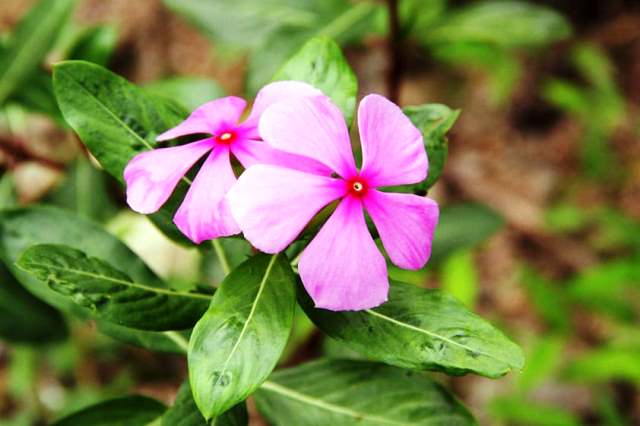
Has a variety of shades of pink petals. The eyes are yellow or crimson. It blooms all year round under favorable temperature and light conditions.
Katarantus ampelous (cascade)

It has long, up to 1.5 m falling to the bottom of the lash, the entire length of which is decorated with red flowers from the axils of dark green leaves.
Aristocrat

Shoots form a spherical crown. Abundant flowering occurs in the second half of summer. The flowers are large, with a contrasting eye. The petals range from white to scarlet.
Pacifica

The crown of the bush is low, compact. Flowering is not very plentiful, but large flowers look spectacular on bright large leaves. In all varieties of the variety, the center of the flower is decorated with a contrasting eye. The most popular varieties of the Pacific:
Burgundy
Epticot
White
First kiss

The shape of the bush is cylindrical, up to 40 cm high. The leaves are elongated, bright green. The flowers are large, the petals can have various shades of pink. The eye is of a more saturated color to match the petals.
Useful articles from the "Floral" section:
Useful articles for the gardener:
- Pansies: planting dates, cultivation and care in the open field
- When to Dive Eggplant in 2020: Auspicious Days
- Planting grapes in 2020: timing, cultivation and care
- Potted hyacinth: growing and care at home
- Lunar calendar of gardeners and gardeners for November 2019
- When to harvest walnuts: timing, storage
- Mushroom picker calendar 2020: when to collect, auspicious days
- Autumn work in the garden and garden: what needs to be done
- Do I need to dig a garden before winter: timing, what fertilizers to apply
- Apricot compote for the winter: delicious and simple recipes
Popular varieties
The plant is cultivated in many varieties. The most popular is pink catharanthus. The rest of the varieties are its derivatives.
Table 2. Varieties of catharanthus
| Variety | Description |
|---|---|
| Catharanthus pink | Leaves are lanceolate, whole-edged with a characteristic white vein. The height of the stem is 60 cm, the length of the leaves is up to 7 cm. The flowers are pink with a bright crimson or yellow eye. In southern latitudes it blooms all year round, in temperate latitudes - in spring and summer. |
| First Kiss | A popular variety series with a striking appearance. The height of the shrub is up to 40 cm. It consists of 13 varieties with different shades of petals. Shrubs with a blue-violet color are considered the most expressive. |
| Pacific | The size is small - up to 30 cm, in diameter reaches only 20 cm. Flowers of a burgundy shade with a snow-white eye. Some species have an apricot shade of flowers and a scarlet central part, or snow-white with a red core. The plant is distinguished by early flowering. |
| Aristocrat | A semi-shrub up to 0.5 m long. The flowers are massive, up to 5 cm in diameter. The color range is from white to scarlet. Grown as indoor and horticultural crops. |
| Cascade | Miniature variety series. The maximum height of the bush is 15 cm, the shoots develop up to 150 cm.The diameter of the flowers is up to 5 cm. The color is not monochromatic, which is not typical for quarantines. At the edge of the flowers, the shade is different from the main part of the petal. |

Variety "Pacific"
Transfer to a permanent place
A transplant to a permanent place, in the ground or in a pot, is usually carried out 2 months after the emergence of friendly shoots. If the catharanthus are intended to decorate the flower beds, they are pre-tempered for a week, taking them out into the street or balcony, first for 30 minutes, then for a longer period of time. Before disembarking, the bush should already spend the night on the street.
Catharanthus grown in a pot or container culture are transplanted into larger pots. The volume depends on how many plants are going to be placed in it. It is not recommended to plant a catharanthus one at a time - the bush will be sparse, completely unlike advertising photos.
More Reproduction of catharanthus by cuttings at home
If, nevertheless, the florist decided to place one plant in the pot, take a liter container. When 3-5 catharanthus are planted, the volume increases to 2-4, and sometimes 5 liters. The pot must have bottom holes.
Transplant process:
- A drainage layer with a height of at least 3-5 cm is placed on the bottom, the substrate for Saintpaulias or geraniums is poured, slightly compacted.
- In the center, make a hole in the size of a glass of seedlings.
- Carefully remove the catharanthus from the individual container, trying not to disturb the lump of earth braided by the roots, and put it in the hole.
- The soil is leveled and watered.
When transplanting a catharanthus to a permanent place, an earthen lump braided by roots cannot be destroyed If the roots have braided the earth well in a glass, and the aboveground part looks healthy, the first feeding of the seedlings can be carried out immediately
Here you need a complex fertilizer containing nitrogen, phosphorus and potassium in equal amounts - this is an important condition. The formula is always given on the package.
Further, the culture is fed with fertilizers for decorative flowering plants.
What if the plant does not take root?
A plant not always planted in open ground takes root. If the acclimatization of the catharanthus does not occur for a long period, then the shrub should be returned to the room. To do this, you should:
- Dig the plant out of the ground and shake off the roots thoroughly.
- Plant in the same soil and moisten a little.
Sometimes, gardeners, not understanding the features of the chosen variety, make a big mistake - they plant flowers in open ground that are not intended for this. Therefore, the plant does not take root. Before starting a particular plant, you should carefully study the growing conditions.
Another reason why the catharanthus does not take root is the incorrectly chosen landing site.
In any case, in order to save the plant, it is necessary to return the catharanthus to home conditions. To begin with, you should create an optimal temperature and humidity regime in the room, do not forget about regular watering and spraying from a spray bottle.
Important! Until the plant recovers, it should not be fed.
Katarantus is a plant that not only perfectly complements any interior, but also has useful properties.It is used in traditional and folk medicine to treat various diseases. Catharanthus juice is poisonous, this should be taken into account when choosing a planting site for a shrub so that children cannot get to it.
From our special publications you can learn about the features of the ampelous and pink catharanthus.
Growing and caring for a catharanthus at home
Katarantus ampelous is unpretentious, but you still have to take care of it. It needs to be watered on time, to monitor the temperature.
Important! The flower should not be kept in direct sunlight. It can lead to illness and even death.
Optimal light and comfortable room temperature
The required temperature should be between 18 and 23 degrees. Do not forget about the pedigree of the flower (tropics). In springtime, you should regularly take the plant out into the garden or just outside.
An important condition for this plant: warm, light weather
The flower is most often placed on the windowsill. If there is no window in the room or there is little sunlight, artificial lighting is created. You need to use a regular 150 watt light bulb per square meter. This is quite enough for such a light-loving creature.
Watering and humidity
Correct and timely moistening of soil and air is in second place after sunlight. Abundant watering is done in hot weather 2 times a day
It is very important to monitor the moisture in the soil.
With an excess of water, the root system decays and the flower dies. The humidity level in the room can be controlled using a special apparatus (humidifier). If this is not possible, then you should spray the plant with water from a spray bottle every day.
Additional Information! Pouring expanded clay into a tray with a pot, you can keep moisture in the room for a long time.
Indoor catharanthus needs an increased amount of moisture.

A flower in the right conditions.
Typical diseases and pests
A beautiful appearance is a sign of a healthy plant. Lethargy, dry leaves, pale color - all this indicates improper care and conditions of detention.
- The appearance of spots and bumps on the surface of the leaves, as well as abscesses on the lower part. The reason for this is the increased humidity of the air and soil.
- Yellow or dry ends of the leaves - lack of moisture.
- A small number of flowers. It happens very often during the cold season.
- Increased root activity - time for transplant.
- Parasites, ticks, spider spiders are dangerous enemies. They are carried by the wind, transferred from other plants. The best way to deal with them is disinfection. It is necessary to soak the brush in an alcohol solution and treat all affected areas once a week.

Catharanthus Ampelny in the wild
Possible problems when growing catharanthus
Ampelous catharanthus is a heat-loving plant. His main need is a comfortable temperature in the room or outside the window. Depends on the location of the flower. With proper observance of all points for flower care, problems should not arise. Having dismissed the flowers, the catharanthus as a token of gratitude will present its owner with beautiful brown flowers, as well as a dense shrub. It will hang majestically from a 2 meter height or from an ordinary window sill. In the southern regions, the ampelous catharanthus can be safely bred right in the open air, since cultivation and care in such a warm climate will benefit the flower, and will not become a burden to its owner.
Note! With a lack of light, the flowers of the catharanthus deform, become more elongated and change color. Such a unique flower is a wonderful decoration of the interior not only of a house or apartment, but also of the facade of a building.
Such a unique flower is a wonderful interior decoration not only for a house or apartment, but also for the facade of a building.

